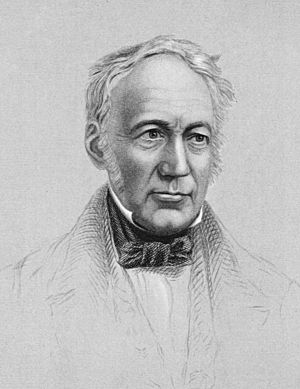Andrew Ure facts for kids
Quick facts for kids
Andrew Ure
|
|
|---|---|

Andrew Ure
|
|
| Born | 18 May 1778 Glasgow, Scotland
|
| Died | 2 January 1857 (aged 78) London, England
|
| Nationality | Scottish |
| Spouse(s) | Catherine Monteath 1807 - 1819 (divorced) |
| Scientific career | |
| Fields | Medicine, chemistry, and natural philosophy |
| Institutions | Andersonian Institution, Glasgow |
Andrew Ure (18 May 1778 – 2 January 1857) was an important Scottish scientist. He was a doctor, chemist, and someone who studied how businesses work. He also founded the Garnet Hill Observatory. Andrew Ure was a member of important groups like the Royal Astronomical Society and the Royal Society. He wrote many books based on his work helping factories and industries.
Contents
Early Life and Education
Andrew Ure was born in Glasgow, Scotland, in May 1778. His father, Alexander Ure, was a cheesemonger. In 1801, Andrew earned his medical degree (MD) from the University of Glasgow. For a short time, he worked as an army surgeon. Then, in 1803, he moved back to Glasgow.
Academic Career and Discoveries
After returning to Glasgow, Ure joined the Faculty of Physicians and Surgeons. In 1804, he became a professor at the Andersonian Institution. He taught natural philosophy, which included chemistry and physics. His evening classes were very popular. They even helped inspire the creation of similar schools in Paris, France, and other parts of Britain.
In 1808, Ure started the Garnet Hill Observatory. He and his wife lived there for several years. This observatory was very well-known, almost as famous as the one in Greenwich. While there, a famous astronomer named Sir William Herschel helped him. Herschel helped Ure set up a new 14-foot reflecting telescope that Ure had designed and built himself. In 1811, Ure became a member of the Royal Astronomical Society.
In 1814, Ure visited Belfast to give lectures. He also helped the Irish linen industry. He invented a tool called an 'alkalimeter'. This tool could measure the amount of alkali in industrial materials. He was known for his excellent practical chemistry skills.
In 1818, Ure helped a professor named James Jeffray with some experiments. They were studying the body of a man who had been executed. Jeffray believed that by stimulating certain nerves, it might be possible to bring someone back to life after suffocation, drowning, or hanging. Ure described how stimulating nerves caused the body's muscles to move. He noted that stimulating a nerve in the face caused many facial muscles to react strongly.
Consultant and Author
In 1821, Andrew Ure published his first big book, Dictionary of Chemistry. This book replaced an older chemistry dictionary. In 1822, he was chosen as a Fellow of the Royal Society.
By 1830, Ure decided to leave his teaching job. He moved to London and started working as a consulting chemist. He was likely one of the first people in Britain to do this full-time. His work included giving expert opinions in legal cases and working for the government. He also traveled to factories in England, Belgium, and France.
His visits to English textile factories led him to write two important books: The Philosophy of Manufactures (1835) and An Account of the Cotton Industry (1836). These books looked at the conditions in textile factories. Because of his time in factories, he also thought about how to heat and ventilate buildings for workers. He is even credited with being the first to describe a bi-metallic thermostat, a device used to control temperature.
Ure's most important and largest work was the Dictionary of Arts, Manufactures and Mines, published in 1837. This huge book was updated many times. It was translated into almost every European language, including Russian and Spanish. The Times newspaper said it was a book of "vast research."
Geology Studies
Andrew Ure was also interested in geology, the study of Earth's history. In 1829, he published a book called A New System of Geology. He was also an original member of the Geological Society of London. Ure believed that geology was a "magnificent field of knowledge."
However, some people did not like his book. Ure believed that geology should agree with the Bible. He thought that since both geology and the Bible were from God, they would match if understood correctly. He said that studying how the Earth works today is science. But understanding the Earth's very distant past involves more speculation, as we cannot observe it directly.
Personal Life and Death
Andrew Ure married Catherine Monteath in 1807. Their marriage ended in 1819.
Ure passed away in London in 1857. He had many friends and often communicated with leading scientists around the world. They all felt his loss deeply. Michael Faraday, another famous scientist, said that Ure's "skill and accuracy were well known." He also noted that "no one of his results has ever been questioned."
Andrew Ure is buried in the Terrace Catacombs of Highgate Cemetery in London. His daughter, Katherine MacKinlay, also placed a memorial for him in Glasgow Cathedral.
Selected Works
- A Dictionary of Chemistry
- A New System of Geology
- The Philosophy of Manufactures: or, An Exposition of the Scientific, Moral, and Commercial Economy of the Factory System of Great Britain
- The Cotton Manufacture of Great Britain
- Dictionary of Arts, Manufactures and Mines
- An Account of the Cotton Industry
Images for kids



